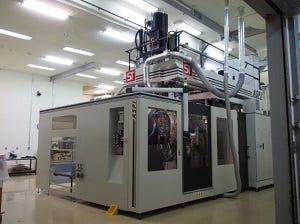3D suction blow molding and injection molding capabilities have been installed at DuPont Performance Polymers technical and R&D centers in the Asia-Pacific region in order to strengthen application development capabilities there.
July 9, 2015
3D suction blow molding and injection molding capabilities have been installed at DuPont Performance Polymers technical and R&D centers in the Asia-Pacific region in order to strengthen application development capabilities there.
The new 3D suction blow molding capability at the Utsunomiya Technical Center in Japan will help DuPont better collaborate and drive air-duct development for automotive turbo charged engines. DuPont has developed in-house simulation tools to predict the 3D suction process and tube twist in the mold to help ensure uniform wall thickness. This investment and the company's unique 3D suction blow molding simulation software will help customers optimize air duct design without physical prototyping.
 DuPont adds processing capabilities to facilities in China (a 450-tonne injection molding machine) and Japan (a 3D suction blow molding machine).
DuPont adds processing capabilities to facilities in China (a 450-tonne injection molding machine) and Japan (a 3D suction blow molding machine). Further, a new 450-ton injection molding machine as well as a 3,800-square-foot DuPont Shanghai Innovation Center have been co-located in the company's China R&D Center, which enhances its regional abilities to help automotive and consumer electronics customers bring innovation to market quickly and cost effectively.
Further, a new 450-ton injection molding machine as well as a 3,800-square-foot DuPont Shanghai Innovation Center have been co-located in the company's China R&D Center, which enhances its regional abilities to help automotive and consumer electronics customers bring innovation to market quickly and cost effectively.
"Our emphasis on design, materials and processing solutions reflects our holistic approach to collaborate with customers," said Woong Chung, technical service manager of DuPont Performance Polymers Asia Pacific. "The new injection molding equipment expands the tools and resources available to customers in China and Asia Pacific as we quickly develop and commercialize new components and systems. At the same time, the drive to improve collaboration is changing how we work together and we are seeing strong results as we have taken time, cost and risk out of the product development cycle."
One of the drivers behind the growth that affords these investments relates to an increasing need for high performance, lightweight plastics to lower vehicle weight. Further, the air duct market is rapidly growing due to global high demand for turbo-charged engines.
In the handheld and consumer electronics market, the need for design flexibility is driving engineers towards high-performance plastics so they can continue to refresh the look, feel and upgrade performance. The 450-ton injection molding machine will help design engineers support the thin-wall molding for handheld devices, test tooling, optimize processing technology, develop prototypes and access advanced CAE (computer-aided-engineering) capabilities on anisotropic properties characterization.
About the Author(s)
You May Also Like


